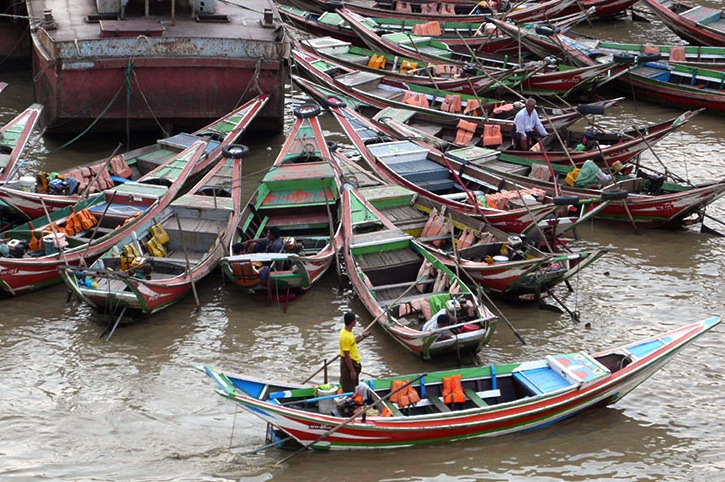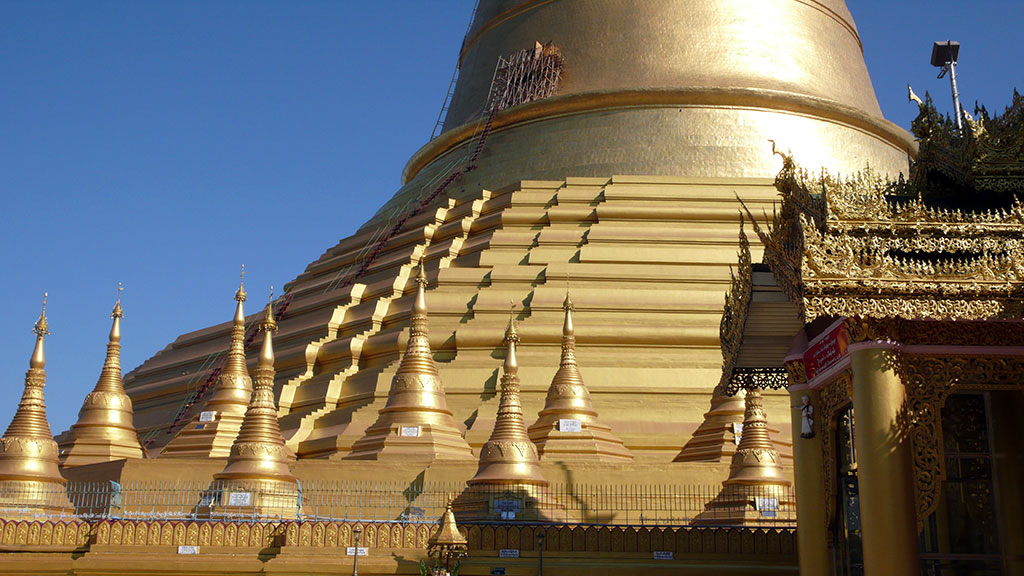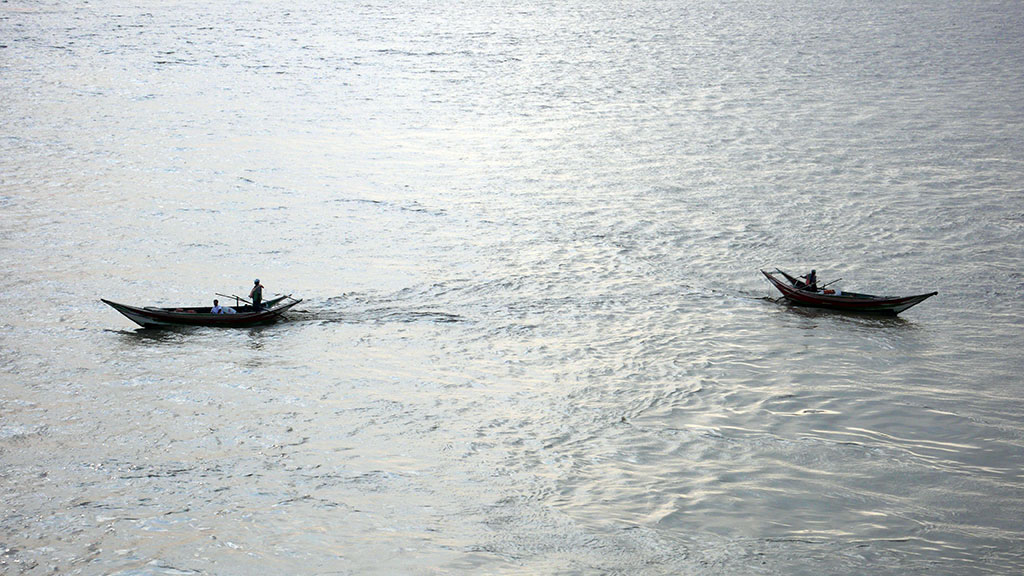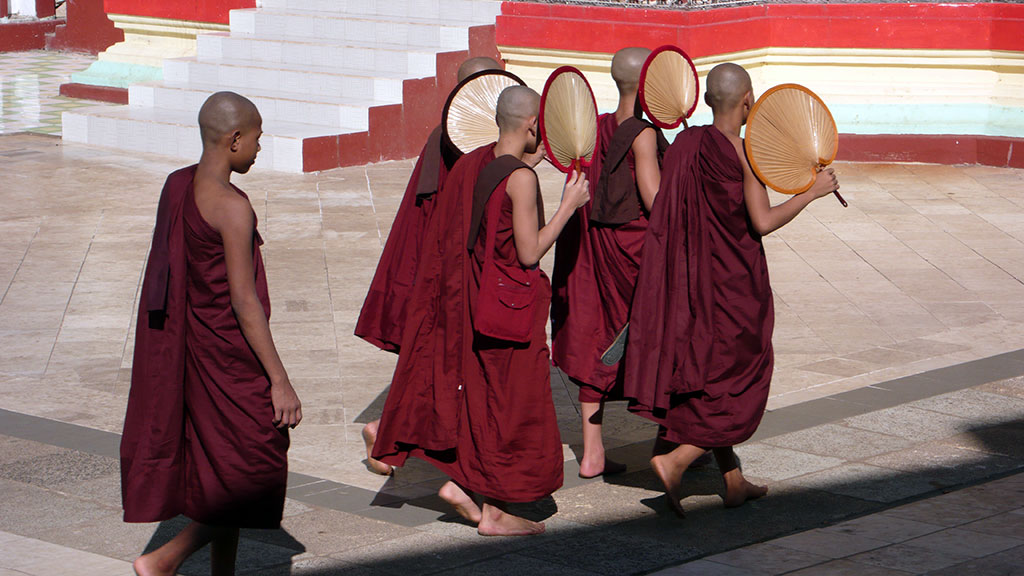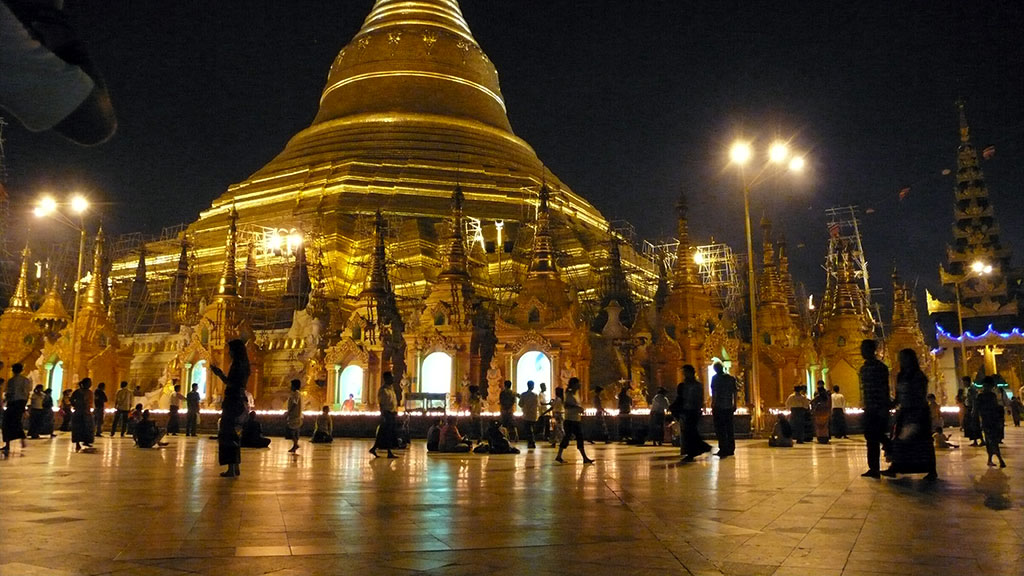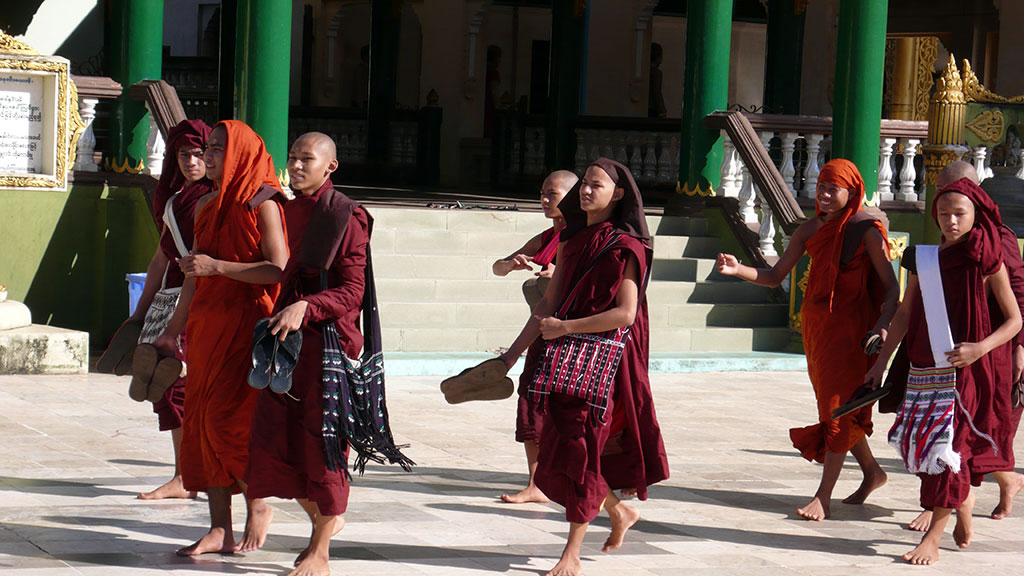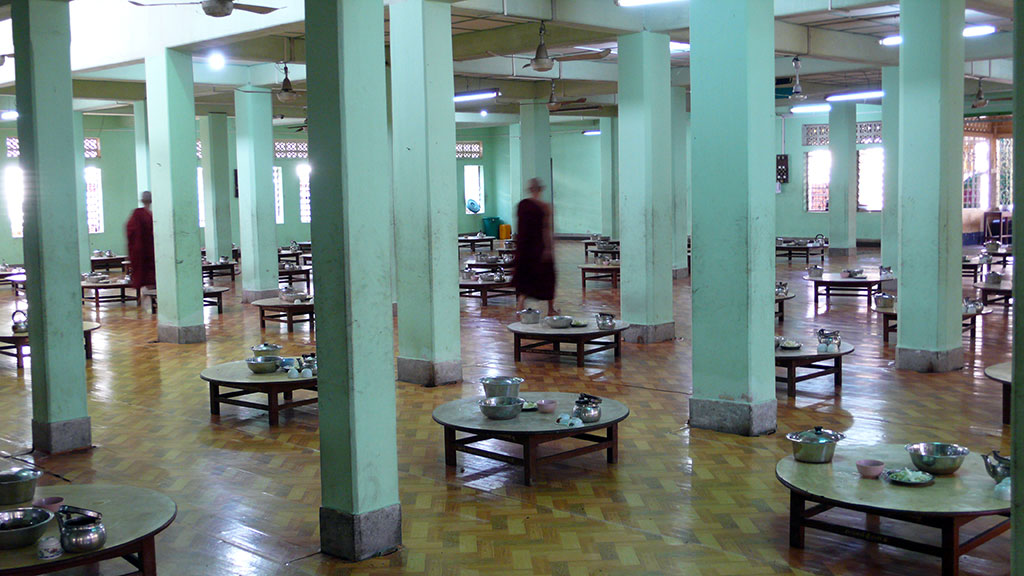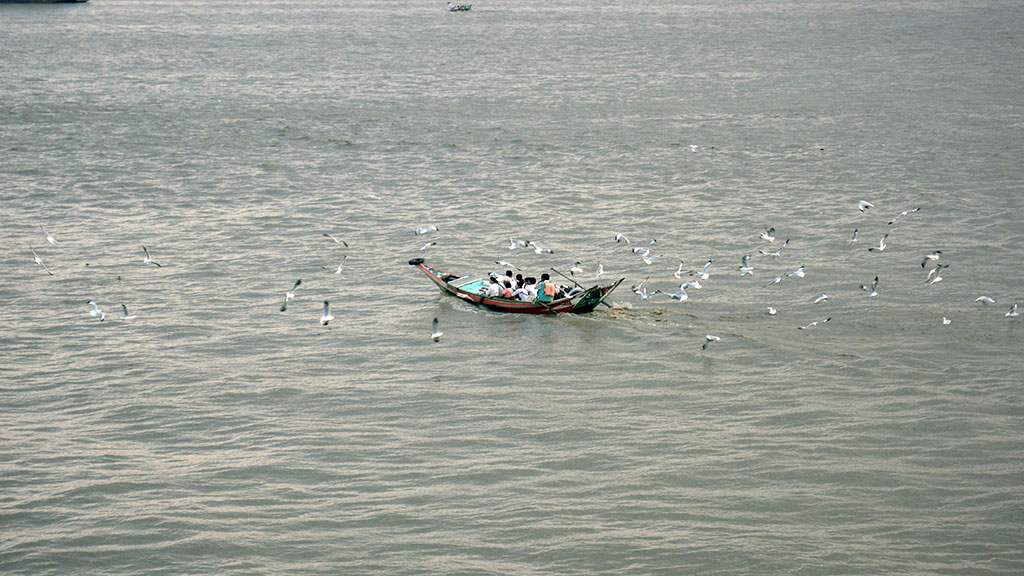Late in the tropical evening torpor of Yangon, we strolled along Strand Road, named for the Strand, the venerable Victorian hotel built in 1901 by the Sarkies brothers who also built Raffles in Singapore.
We’d been drinking Pegu Clubs and Strand Sours at the Strand Bar, playing billiards with a cast of louche characters who might’ve escaped from the pages of a novel by Graham Greene or Paul Theroux. Happy Hour at the Strand on Fridays carries on some of the bibulous traditions established when the Strand was considered “the finest hostelry East of Suez” and a favored haunt of royals, diplomats, and notables such as Somerset Maugham, George Orwell, Sir Noel Coward, and Rudyard Kipling.
At the corner, we saw him again, seated beneath a tree on a doll-size plastic chair at one of those makeshift restaurants that populate the broken pavement that passes for sidewalks all through Yangon, once known as Rangoon. Seeing us, his face broke into a broad smile, his teeth as white and straight as an advertisement for the benefits of orthodontia.
“Come sit with us,” he said as he stood to greet us, his hand extended. “What do you want to drink?”
He was wearing the traditional “longyi,” that fascinating sheet of cloth that runs to the feet and is held in place around the waist without a knot, and a tightly-fitted oxford shirt open from his neck to the depths of his sternum, revealing a darkly-haired chest. His swarthy beauty was the kind that often appears on a runway in Milan.
We’d met him the night before as we’d headed back to the ship after an evening at the Strand. He and his equally attractive friend had passed us on the sidewalk and then glanced back and smiled. We’d stopped and talked and he’d given us an email address: lovelymodelboy@hotmail.
Burma is a land of contrasts. Officially rechristened Myanmar in 1989, the name Burma is still widely used by governments around the world. One of the most impoverished countries on the planet, the consequence of nearly fifty years of military rule, Burma endures energy shortages, unpaved highways, and inadequate infrastructure. Sandwiched between India and China, the two most populated countries in the world, Burma has a population of nearly 60 million living in a country that is roughly the size of France and Britain combined.
Though the country achieved independence from Britain in 1948, vestiges of British rule linger on nearly every corner in downtown Yangon with its vast array of colonial buildings, some in desuetude and others, like the Custom House and the Anglican Cathedral and the Strand, impeccably restored to their original glory. This remarkable collection of National Landmarks, more than 128 historic buildings, coexists with street fire pots, unpaved roads, and broken sidewalks.
“Come. Sit down,” lovely model boy said, offering us two of the plastic doll-size chairs. His friend was with him, also smiling at us and motioning for us to sit. “What do you want to drink?”
“A gift for you,” he said, offering us two sharpened twigs from a plastic bag that contained scores more, all orderly and arranged like a box of freshly-sharpened pencils.
“For your teeth,” he said smiling and showing us how to utilize the sharpened point against our gums and enamel. He smiled broadly, his white teeth a testament to the powers of this botanical toothbrush.
Founded in 1755, the town formerly called Dagon was renamed Yangon, meaning “end of strife.” Yet Burma is a country that endured three Anglo-Burmese Wars with Britain between 1824 and 1885, as well as the devastation and heavy tolls of WWII during which the Japanese defeated the British, before Allied troops launched a series of counteroffensives that ravaged the country. Decades of military rule and oppression were followed by Cyclone Nargis in 2008, the worst natural disaster in Burmese history, which left more than 1 million Burmese homeless.
What was there to smile about? Earlier that day, our guide on the motorcoach had broken down in tears upon responding to a question about life under the military regime – and her heartfelt soliloquy about the regime’s impact on her family had left her listeners stunned and still.
And yet, everywhere we went in Burma, we were greeted with smiles and ingenuous offerings of hospitality and kindness.
“You are here before this country has been sanitized by tourism,” another guide reminded us. The dissolution of the military junta occurred in March 2011: we were witnessing the first stirrings of democracy – perhaps not unlike the first months after the Americans threw off the British military in 1783. Recent visitors to Burma are similar to diplomats for the rest of the world – and Obama’s visit in November 2012, two weeks after his re-election, was the first visit to the country by a sitting President of the US.
With a 1,200-mile coastline along the Bay of Bengal and the Andaman Sea, Burma has been attracting visitors since at least the 1st century AD when sailors, as recounted by Ptolemy, crossed the Bay of Bengal on trading voyages from the Ganges to the Strait of Malacca.
Lovely Model Boy’s name was Khan, which he’d spelled out for us the night before on a sheet of paper – perhaps so that we would not mistake it for its homophone “con.” “We are so lucky to meet each other,” he said, smiling again.
Khan worked in a monastery, teaching English to the young monks. “Hesse,” he said. “Siddhartha. And Hemingway.” He smiled and nodded. “And Dale Carnegie. Do you know him?”
Burma’s newly-introduced flag features three stripes, which symbolize solidarity, peace and tranquility, and courage. Nearly 90% of Burma’s population is Buddhist and Buddhist monks were at the forefront of the independence movement in 1948, which was a harbinger to the Saffron Revolution in 2007.
The most sacred pilgrimage site in all of Burma is the 2,600-year-old Shwedagon Pagoda, a reliquary of four Buddhas, which includes eight hairs from Lord Buddha, the founder of Buddhism. Topped by a 76-carat diamond and sheathed in gold plates (with more than 4,500 diamonds), the pagoda’s 320-foot stupa dominates the Yangon skyline.
A visit to Shwedagon in the evening, around sunset, is one of the most mystical experiences imaginable in Burma. Buzzing with the chants and prayers of Buddhist monks and worshippers, Shwedagon is a wonderland of shimmering light and candles, flowers and flags, and the glow of gold in the gloaming. In the words of Kipling, Shwedagon is “a golden mystery…a beautiful winking wonder.”
As with many Burmese, Khan and his friend frequented tea shops, often to watch foreign movies. “Slumdog Millionaire,” exclaimed Khan’s friend. “It’s my story,” he said, thumping his chest and smiling wide.
The divide between the classes in Burma is often reduced to the phrase “long sleeve” and “short sleeve,” which is shorthand for the distinction between between those with money – and the day laborers. It’s telling that while Burma mines more than 90% of the world’s rubies, Burmese rubies are banned in the US due to the slave labor conditions in the mines.
One morning, we are escorted out of Yangon by a police escort: six motorcoaches flanked by police cars, which lead us through the city traffic to the outskirts of town. We’re headed for the Kya Khat Wai Monastery, where we’ll witness the monks in their chosen environment. For many young Burmese males, time in the monastery is a rite of passage that might also become a lifelong vocation.
Is it this meditative period during their formative years that provides so many Burmese adults with an aura of inner peace? In spite of the quotidian difficulties, economic hardship and sectarian strife, people in Burma project a calm that permeates the breadth of civilian life.
“That is your ship?” Khan asks, pointing beyond the jetty to where our ship is docked. “We never see a ship like this before.”
The two of them had never been out of Burma. They had no passports, they said, explaining to us the difficulty in obtaining a Burmese passport. “How much does it cost?” they asked. “How much to travel in a ship like that?”
At evening’s end, after Khan and his friend had walked us to the manned security gate beyond which our ship was docked, we gave Khan and his friend a fistful of dollars, all the American money we had in our pockets.
“For the monastery,” we said. “For medicine. For the little monks,” we said. But maybe it was because of Khan’s white teeth and his smile. Or because of their youth and their ingenuousness. The sincerity in which they greeted us with such happiness and enthusiasm. Or because the money meant nothing to us – and so much more to them.
Khan opened his arms wide. “We want to say goodbye like Americans,” he said, waiting for a hug.
In 1961, U Thant, the Burmese diplomat and UN representative, was elected Secretary-General of the UN, a position he held for ten years. After Thant’s retirement, The New York Times wrote that “the wise counsel of this dedicated man of peace will still be needed.”
The same might be said about the many citizens of Burma whose daily practices herald a more humanitarian society.
“We will never forget you,” Khan’s friend cried out to us as the gate swung shut behind us.
We felt the same.
IF YOU GO/GETTING THERE:
If you yearn to travel to Kipling’s “winking wonder,” you might consider a cruise aboard the Aegean Odyssey, a mid-sized ship designed for coastal cruising. Winner of the “Best Specialist Cruise Line 2012,” Voyages to Antiquity’s Aegean Odyssey inaugurated their Southeast Asia cruises two years ago.
An eight-deck ship with a capacity of 380 passengers and 180 crew members, the Aegean Odyssey easily navigates the great rivers of Southeast Asia and fits comfortably into smaller harbors. The two-to-one passenger/crew ratio affords a remarkable degree of pampering aboard a ship where the drink of choice is Champagne and where the majority of guests hail from Britain, the US, and Canada. More than one third of the passengers are repeat visitors, which creates a convivial on-board atmosphere similar to an extended family reunion. Daily lecturers include the estimable British war correspondent Martin Bell and the authors of tomes on Burma’s Nobel Peace Prize winner Aung San Suu Kyi and the history of Burmese democracy.
As Kipling wrote in 1889, “This is Burma, and it will be quite unlike any land you know about.” A cruise on the Aegean Odyssey provides the perfect opportunity for that “once-in-a-lifetime” visit to a land that has fascinated travelers since the ancients.
LINKS: Voyages to Antiquity

